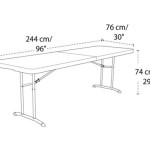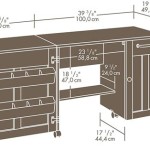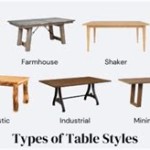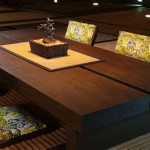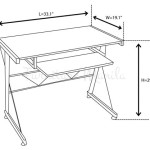DIY Kitchen Table Top Ideas: A Comprehensive Guide
The kitchen table serves as a focal point in many homes, a place for meals, conversation, homework, and more. Over time, table tops can become worn, scratched, or simply outdated. Rather than replacing the entire table, a DIY table top project offers an affordable and customizable solution. This guide explores various materials, techniques, and design ideas for crafting a unique and durable kitchen table top.
Material Selection: Foundations for a Durable and Stylish Table Top
The choice of material is paramount in determining the longevity, aesthetics, and functionality of a kitchen table top. Several options cater to different budgets, skill levels, and design preferences.
Solid Wood: Solid wood remains a popular choice for its natural beauty, durability, and versatility. Hardwoods like maple, oak, cherry, and walnut offer superior resistance to scratches and dents, making them ideal for high-traffic kitchens. Softwoods, such as pine and fir, are more affordable but require more careful handling and a robust finish to prevent damage. When selecting solid wood, consider the grain pattern and color, as these will significantly influence the overall appearance of the table. Edge-glued panels offer a convenient option for creating a wider table top without the complexity of joining individual boards. These panels are pre-assembled with tight seams, ensuring a stable and visually appealing surface. Consider the sustainability of your wood source, opting for responsibly harvested options.
Reclaimed Wood: Reclaimed wood provides character and history while reducing waste. Sourced from old barns, factories, or other structures, reclaimed wood boasts a unique patina and texture that cannot be replicated with new materials. However, working with reclaimed wood requires careful preparation. Thoroughly clean the wood to remove dirt, nails, and other debris. Inspect for pests and treat as needed. Leveling the surface may require planing or sanding, and gaps or imperfections can be filled with epoxy resin for a smooth, functional surface. The imperfections in reclaimed wood often add to its charm, creating a one-of-a-kind kitchen table top.
Butcher Block: Butcher block is a durable and attractive option, particularly well-suited for kitchens. Constructed from multiple pieces of wood glued together, it provides a robust surface that can withstand heavy use. Butcher block is typically available in various thicknesses and wood species, allowing for customization to suit individual needs and preferences. Consider the end-grain versus edge-grain orientation. End-grain butcher block is more durable and resistant to knife marks but also more expensive. Regular oiling is essential to prevent drying, cracking, and staining. Mineral oil or butcher block oil are recommended for food safety.
Concrete: Concrete table tops offer a modern and industrial aesthetic. They are highly durable and heat-resistant, making them suitable for kitchens where hot dishes are frequently placed on the table. Creating a concrete table top involves building a mold, mixing and pouring the concrete, and allowing it to cure properly. Reinforcement with wire mesh is crucial to prevent cracking. After curing, the surface must be polished and sealed to prevent staining and water damage. Concrete table tops can be heavy, so ensure the table base is sturdy enough to support the weight.
Epoxy Resin: Epoxy resin can be used in conjunction with other materials, such as wood, to create stunning and unique table tops. It can be poured over wood to create a clear, glossy finish or mixed with pigments and other additives to create colorful and artistic designs. Epoxy resin is durable, water-resistant, and easy to clean. When working with epoxy resin, follow the manufacturer's instructions carefully, paying attention to mixing ratios, curing times, and safety precautions. Proper ventilation is essential during the pouring and curing process.
Construction Techniques: Crafting a Solid and Visually Appealing Table Top
The construction method employed significantly impacts the stability, durability, and aesthetic appeal of the finished table top.
Joining Boards: When using individual boards to create a table top, proper joining techniques are crucial. Edge joining involves gluing the edges of the boards together to create a wider panel. Clamps are essential to apply even pressure during the gluing process, ensuring a strong and seamless bond. Biscuit joints, dowels, or tongue-and-groove joints can be used to reinforce the joint and improve alignment. The choice of joining method depends on the type of wood, the size of the table top, and the desired aesthetic.
Creating a Frame: Framing the table top with wood adds structural support and enhances its visual appeal. A frame typically consists of four pieces of wood that are attached to the underside of the table top, creating a border around the perimeter. The frame can be attached with screws, glue, or a combination of both. Mitered corners offer a clean and professional look, while butt joints are simpler to execute. The frame also provides a convenient surface for attaching the table top to the base.
Adding an Edge Detail: Edge details can dramatically enhance the appearance of a table top. Chamfers, rounds, and ogee profiles can be created with a router and appropriate bits. These details soften the edges of the table top and add a touch of elegance. However, an edge detail is not essential and a simple square edge can also be perfectly acceptable and aesthetically appropriate depending on the overall design.
Finishing: The finishing process protects the wood from moisture, stains, and scratches while enhancing its natural beauty. Sanding is essential to create a smooth surface before applying any finish. Start with a coarse grit sandpaper and gradually work your way up to a finer grit. Dust thoroughly after each sanding stage. Various types of finishes are available, including varnish, polyurethane, oil-based finishes, and water-based finishes. Varnish and polyurethane provide a durable and water-resistant finish, while oil-based finishes penetrate the wood and enhance its natural grain. Water-based finishes are low in VOCs and dry quickly, making them a more environmentally friendly option. Consider the intended use of the table top and choose a finish that is appropriate for food contact and frequent cleaning. Apply multiple coats of finish, allowing each coat to dry thoroughly before applying the next. Lightly sand between coats for a smoother finish.
Design Considerations: Tailoring the Table Top to Match Kitchen Style
Beyond material and construction, design elements play a crucial role in integrating the table top seamlessly into the kitchen's existing décor.
Shape and Size: The shape and size of the table top should be proportionate to the size of the kitchen and the number of people who will be using it. Rectangular tables are a classic choice, while round tables promote conversation. Square tables are well-suited for smaller spaces. The size of the table should allow for comfortable seating and adequate space for place settings and serving dishes. Consider the flow of traffic in the kitchen and ensure that the table does not obstruct doorways or walkways.
Color and Texture: The color and texture of the table top should complement the existing color scheme and materials in the kitchen. Light-colored woods, such as maple and birch, create a bright and airy feel, while darker woods, such as walnut and cherry, add warmth and sophistication. The texture of the table top can be smooth and polished or rustic and textured. Consider the overall style of the kitchen and choose a color and texture that is consistent with that style. A smooth, glossy finish works well in a modern kitchen, while a distressed finish complements a farmhouse-style kitchen.
Integration with the Base: The table top must be compatible with the existing or planned table base. Ensure that the base is sturdy enough to support the weight of the table top and that the attachment method is secure. The style of the base should also complement the style of the table top. A rustic wooden table top pairs well with a wrought iron base, while a sleek concrete table top complements a modern metal base. Consider the height of the base and ensure that the table is at a comfortable height for dining. Adjustments may be needed depending on chair heights.
Unique Design Elements: Incorporating unique design elements can personalize the table top and make it a standout feature in the kitchen. Inlays, mosaics, and decorative hardware can add visual interest and character. Consider embedding objects, such as shells, stones, or coins, in epoxy resin for a custom look. Stencils can be used to create patterns or designs on the table top. Experiment with different finishes and techniques to create a table top that is truly one-of-a-kind.
By carefully considering materials, construction techniques, and design elements, anyone can create a stunning and durable DIY kitchen table top that enhances the beauty and functionality of their home.

20 Gorgeous Diy Dining Table Ideas And Plans The House Of Wood

10 Diy Dining Table Ideas Build Your Own Room

Diy Zinc Top Kitchen Table Beneath My Heart

10 Diy Dining Table Ideas Build Your Own

My Favorite Diy Kitchen Table Ideas Buy This Cook That

Pin On Hunny Do Togethers

25 Table Top Ideas To Try This Weekend Mod Podge Rocks

25 Table Top Ideas To Try This Weekend Mod Podge Rocks

My Favorite Diy Kitchen Table Ideas Buy This Cook That

Beautiful Dining Table Top Ideas For All One Brick At A Time




